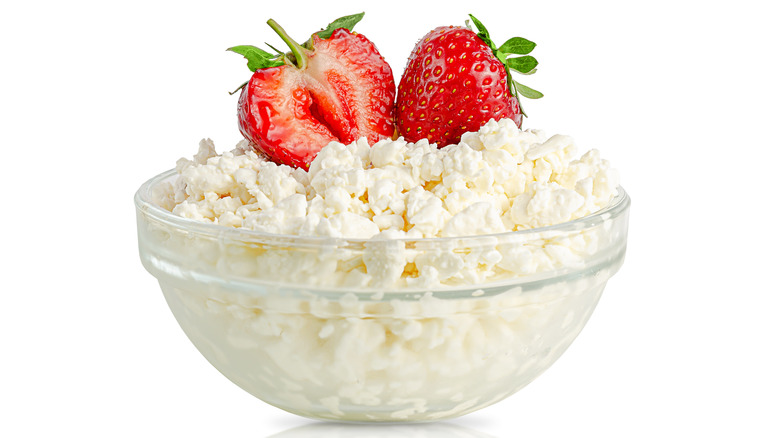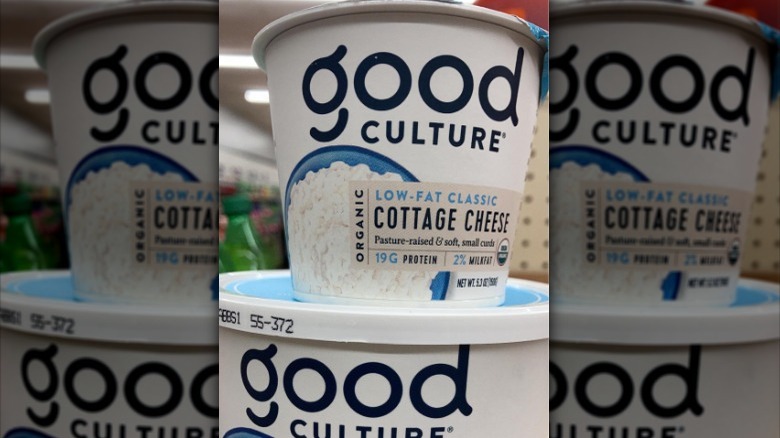What Exactly Is Cottage Cheese (And Is It Making A Comeback)?
There are foods we love to love, like pizza, chocolate, and ice cream (per Food Network) and foods we love to hate, including olives, beets, and anchovies (per Zippia). Cottage cheese is polarizing, too — but don't tell your grandmother that while she's eating a blob of it on top of a bowl of Jell-O or on a canned pear or peach half. Cottage cheese frequently shows up on surveys (not necessarily quantifiable) of foods people dislike intensely. Post a meme on social media that says, "Cottage cheese goes best with...,” and you'll get answers like crackers, pineapple rings, mandarin oranges, and cranberry sauce, interspersed with "the trash can,” "loneliness,” "nothing,” and "the rest of the lasagna ingredients.”
Clearly, cottage cheese has its haters and gets a bad rap. It's touted as a good-for-you (high in protein) and good-for-your-gut dairy product, but it doesn't begin to claim the shelf space that yogurt does at the grocery store. Its "moment” was 50 years ago, in the 1970s, when the average American ate 5 pounds of it a year (per NPR). Then its popularity started waning. But, today, in some circles, cottage cheese is seen as a comeback kid (per Culture).
Cottage cheese is what's known as a 'fresh cheese'
You might be wondering if cottage cheese is real cheese. It most certainly is, but not in the same sense as Swiss cheese, Pepper Jack, Parmesan, and America's favorite cheese, cheddar (per YouGov). Those are hard cheeses. Cottage cheese is what's termed "fresh cheese” (per the United Dairy Industry Association). It's known for its small, medium, or large curds, lumpy yet creamy texture, and slightly acidic taste. It's believed to have come to America from Europe, and its name references where it was likely first made: in farmhouses and cottages. Some have suggested that cottage cheese, which doesn't require aging, was probably the first cheese made in America (per the California Milk Advisory Board).
The main ingredient in cottage cheese is milk — milk plus science. The process involves adding acid or live, active cultures (probiotics), which causes the whey (liquid) and milk solids to separate. After the curd takes shape, it's cut into small pieces and drained, to allow additional liquid to be removed. The curds are later rinsed and usually combined with salt. And sometimes with bits of pineapple and other ingredients.
Newer brands take some cues from yogurt
Cottage cheese is made by producers large and small, and some new brands have entered the marketplace to acclaim, according to Culture. Muuna and Good Culture have given boring old cottage cheese a hip and contemporary look and vibe on store shelves. Muuna is packaged in brightly colored, single-serve containers and comes in flavors like strawberry, peach, mango, and blueberry, as well as low-fat plain (per PerishableNews.com). Good Culture is available in "classic” style, as well as in flavors like strawberry chia and blueberry acai chia. It's organic, produced simply, and "ridiculously good,” according to the website.
TikToker Ryan Kassim (@ryankassim) agrees. In a video liked by more than 76,000 people, Kassim shows the universe how to make cottage cheese taste good (his real words: "not taste like s—”). TikTok LOVES cottage cheese. Kassim's procedure: Dump a container of Good Culture low-fat cottage cheese into a bowl. Sprinkle it with a generous amount of Trader Joe's Everything But the Bagel seasoning. Just for fun, cut a ripe avocado in half and add that to the bowl too, mixing it in. "It's amazing,” he says while eating a spoonful.


